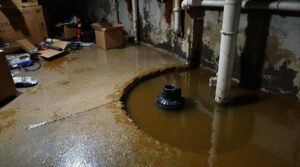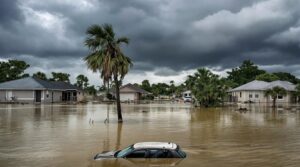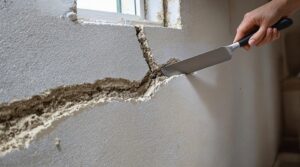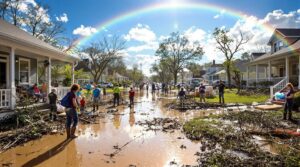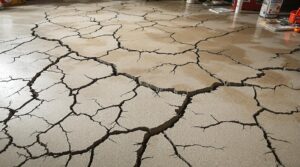Standard homeowners insurance policies typically exclude flood damage resulting from overflowing storm drains, rising water tables, and flash flood events. Homeowners in flood-prone areas face significant financial risks due to these exclusions. Only 27% of homeowners in designated flood zones maintain active flood insurance coverage, indicating a gap in protection for many. To fully understand the limitations of homeowners insurance and the necessity of separate flood insurance policies, it is essential to explore the specifics of flood insurance coverage and its associated costs and benefits.
Key Takeaways
- Homeowners insurance typically excludes flood damage from overflowing storm drains, rising water tables, and flash flood events.
- Standard homeowners policies do not cover flood-related incidents, requiring separate flood insurance policies for protection.
- Only 27% of homeowners in designated flood zones maintain active flood insurance coverage, indicating a significant gap in protection.
- Flood insurance is a separate policy designed for flood-related incidents, with coverage limits and exclusions varying by policy.
- Homeowners should review their policy coverage to confirm if flood insurance is included, as it's often mandatory for properties in designated flood zones.
Types Of Flood Damage Not Covered By Homeowners Insurance
Homeowners insurance typically excludes various types of flood damage, including damage resulting from overflowing storm drains, which can cause severe property damage.
Rising water tables also pose a significant threat to homes, particularly those situated in low-lying areas, and standard policies often do not account for such risks.
Additionally, flash flood events, characterized by sudden and intense flows of water, are another form of flood damage commonly not covered under standard homeowners insurance policies.
Overflowing Storm Drains
Flooding caused by overflowing storm drains is a significant risk for residential properties, particularly in areas prone to heavy rainfall.
Homeowners insurance typically does not cover damage from overflowing storm drains, as this is considered flood damage, which requires a separate flood insurance policy. It is essential for homeowners to understand their policy limitations.
Three key points about storm drain flooding and homeowners insurance:
- Excluded by Standard Policies: Standard homeowners policies explicitly exclude coverage for groundwater seepage, including damage from overflowing storm drains.
- Need for Separate Flood Policy: Homeowners must purchase a separate flood insurance policy to protect against losses caused by storm drain flooding.
- Protection Through NFIP: The National Flood Insurance Program (NFIP) offers specific flood insurance options to help homeowners protect against storm-related flooding damages.
Statistics show that only 27% of homeowners in designated flood zones maintain active flood insurance coverage, leaving many properties vulnerable to storm drain flooding damage.
Rising Water Tables
Because groundwater seepage is typically excluded from standard homeowners insurance policies, damage caused by rising water tables is not covered. This type of flood damage is considered a gradual issue, resulting from increased water levels and subsequent soil saturation.
Homeowners in flood-prone areas face significant financial risks, as rising water tables can lead to extensive property damage without insurance protection. Standard homeowners insurance does not provide coverage for losses incurred due to flooding from rising water tables.
To protect against such flood damage, homeowners must obtain separate flood insurance policies, often through the National Flood Insurance Program (NFIP). Separate flood insurance coverage is essential for homeowners in areas susceptible to rising water tables to mitigate potential losses and financial burdens.
Flash Flood Events
How does one prepare for the unpredictable nature of flash flood events, which can leave a trail of devastation in a matter of minutes?
Homeowners insurance typically does not cover flood damage, including flash floods. To protect against such losses, homeowners must obtain a separate flood insurance policy.
Key considerations include:
- Standard policies exclude flood-related incidents: Homeowners insurance does not cover flooding caused by natural disasters, such as heavy rainfall leading to flash floods.
- Flood insurance provides necessary coverage: The National Flood Insurance Program (NFIP) offers specific coverage for flood damage, which is not included in standard homeowners insurance policies.
- Financial protection is essential: Neglecting to purchase flood insurance in flood-prone areas can result in significant financial losses from flash flood events.
The additional living expenses coverage provided by flood insurance can help cover temporary housing costs while your home undergoes flood-related repairs.
Does Flood Insurance Have A Deductible?
Typically, one of the primary concerns for homeowners considering flood insurance is the potential financial burden associated with filing a claim. Flood insurance, which is often necessary as homeowners insurance typically does not cover flood damage, generally includes a deductible.
This deductible is the amount a policyholder must pay out-of-pocket before insurance coverage is applied. The National Flood Insurance Program (NFIP) offers policies with deductibles ranging from $1,000 to $10,000. Higher deductibles result in lower premiums, allowing homeowners to adjust their expenses according to their financial situation.
Homeowners should carefully review their flood insurance policy to understand deductible terms and their impact on claim payouts. The deductible is applied to each separate claim, making understanding these terms vital for managing potential financial burdens.
How To Determine The Cause Of Water Damage
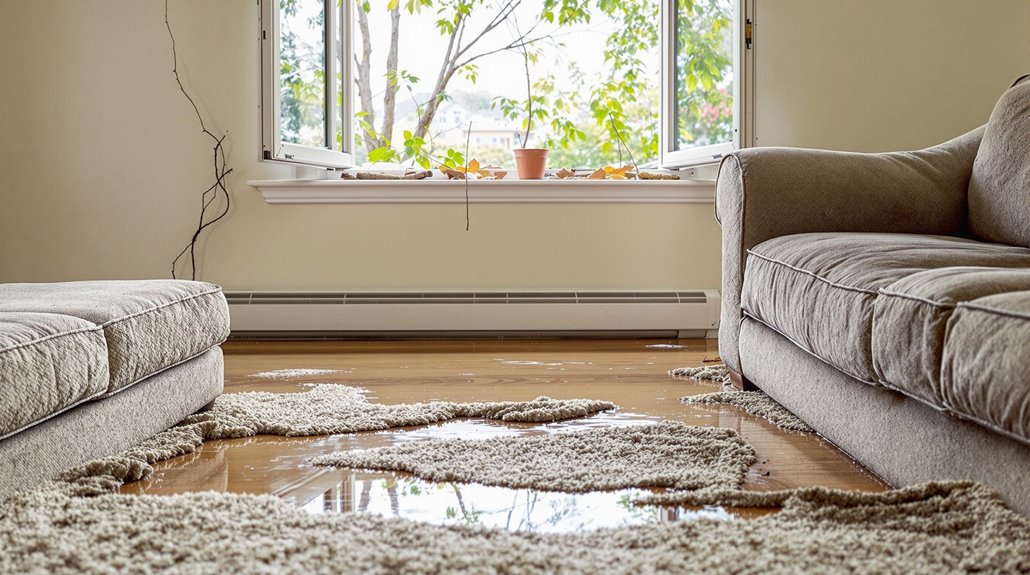
Determining the cause of water damage is an essential step in evaluating insurance coverage eligibility.
To identify the source of the damage, insurers and homeowners must carefully examine the property for signs of water intrusion, such as discoloration, warping, or mineral deposits.
Identifying Water Damage Sources
Numerous factors can contribute to water damage in a home, and identifying the source is essential for determining the extent of insurance coverage. Homeowners must understand that not all water damage is covered by homeowners insurance.
To facilitate water damage claims, it is vital to identify the source of water damage and document the timeline of the incident.
Key steps to identify water damage sources include:
- Visible sources inspection: Look for burst pipes, appliance leaks, or roof leaks, as these are often sudden and accidental events typically covered by homeowners insurance.
- Gradual issue detection: Inspect for slow leaks or seepage through foundation cracks, which may indicate neglect and are usually not covered by insurance.
- Timeline documentation: Record when the water incident started and any contributing weather events to support insurance claims.
Insurance adjusters will evaluate the damage and verify its cause to determine appropriate coverage levels based on your policy.
Assessing Property Damage Signs
Several significant factors come into play when evaluating property damage signs to determine the cause of water damage.
To assess property damage effectively, it is important to inspect the affected area for visible signs of leaks, such as water stains, mold growth, or warped flooring. Documenting the source of water intrusion is essential for insurance claims, as it helps determine whether the damage is covered.
The pattern of water damage, whether sudden and accidental or resulting from ongoing leaks or neglect, also affects coverage eligibility. A moisture meter can be used to assess the extent of water damage in materials like drywall and wood, providing valuable information for insurance claims.
Public insurance adjusters can help navigate complex water damage claims to ensure fair compensation.
Accurate assessment is critical to determine the cause of water damage and guarantee adequate coverage.
Distinguishing Floods From Leaks
When confronted with water damage, how can one differentiate between the ravages of a flood and the consequences of a mere leak?
Determining the cause of water damage is vital, as it directly impacts homeowners insurance coverage and claim outcomes. Flood damage, typically defined as water overflowing from lakes, rivers, or oceans, requires a separate flood insurance policy for financial protection.
The following factors can help distinguish floods from leaks:
- Source of water: Floods originate from external sources, whereas leaks usually stem from internal sources, such as burst pipes or faulty appliances.
- Water level and extent of damage: Floods often result in more extensive damage, with water levels rising considerably.
- Suddenness of the event: Floods are typically sudden and unexpected, whereas leaks may be gradual and accidental.
Standard dwelling coverage typically protects against water damage from internal sources but excludes flood-related incidents.
Who Needs Flood Insurance & Why?
Who should consider purchasing flood insurance? Homeowners residing in flood-prone areas, as designated by FEMA flood maps, are prime candidates for this type of coverage.
However, even those living in low- to moderate-risk areas should consider purchasing flood insurance, as 20% of all flood insurance claims originate from these regions.
Flood insurance is essential for protecting against financial loss caused by flood damage, which is not typically covered under standard homeowners insurance policies.
The National Flood Insurance Program provides policies covering structural damage and personal property losses due to flooding.
Homeowners in areas susceptible to heavy rainfall, storm surges, or melting snow should prioritize flood insurance to mitigate the risk of financial loss. Additionally, understanding the difference between hurricane insurance vs flood insurance is crucial for homeowners in vulnerable regions. While hurricane insurance may cover wind damage and other storm-related incidents, it often does not protect against flooding caused by heavy rainfall or rising water levels. Therefore, securing flood insurance can provide essential coverage that complements existing policies, ensuring homeowners are adequately protected from severe weather-related damages.
This coverage is often mandatory for properties located in designated flood zones.
What Types Of Water Damage Are Covered By Homeowners Insurance
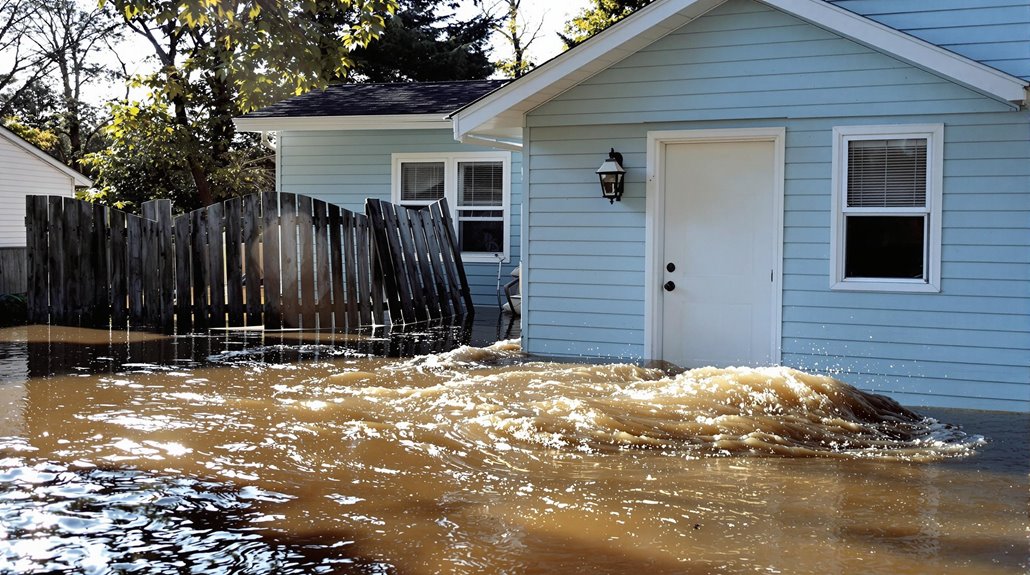
While homeowners insurance provides financial protection against various types of water damage, its coverage is limited to specific circumstances.
Homeowners insurance typically covers sudden and accidental water damage, such as that caused by burst pipes or accidental overflow from appliances.
The following are examples of water damage types that are usually covered:
- *Burst pipes*: Water damage from pipes that burst due to freezing or other unexpected events.
- *Accidental appliance overflow*: Sudden and unexpected water release from appliances, such as a washing machine or dishwasher.
- *Storm-related roof damage*: Water entering through a hole in the roof caused by sudden and accidental storm damage.
However, standard homeowners insurance does not cover flood damage; a separate flood insurance policy is required for adequate protection against such risks.
Homeowners Insurance Policy Limits For Water Damage
Homeowners insurance policies provide financial protection against various types of water damage, but it is equally important for homeowners to understand the limitations of their coverage. Standard policies typically exclude flood damage, requiring a separate flood insurance policy for adequate protection. Understanding coverage limits is vital, especially for those in flood-prone areas.
| Coverage Type | Standard Homeowners Insurance | Flood Insurance Policy |
|---|---|---|
| Water Damage (e.g., burst pipes) | Typically covered | Not applicable |
| Flood Damage | Excluded | Covered, with specific limits |
| Structural Damage | Limited coverage | Covered, with specific limits |
| Personal Property Losses | Limited coverage | Covered, with specific limits |
| Groundwater Seepage | Excluded | Excluded |
Homeowners must evaluate their flood risk and consult with insurance agents to guarantee adequate coverage that meets their needs.
Tips For Purchasing Flood Insurance Policies
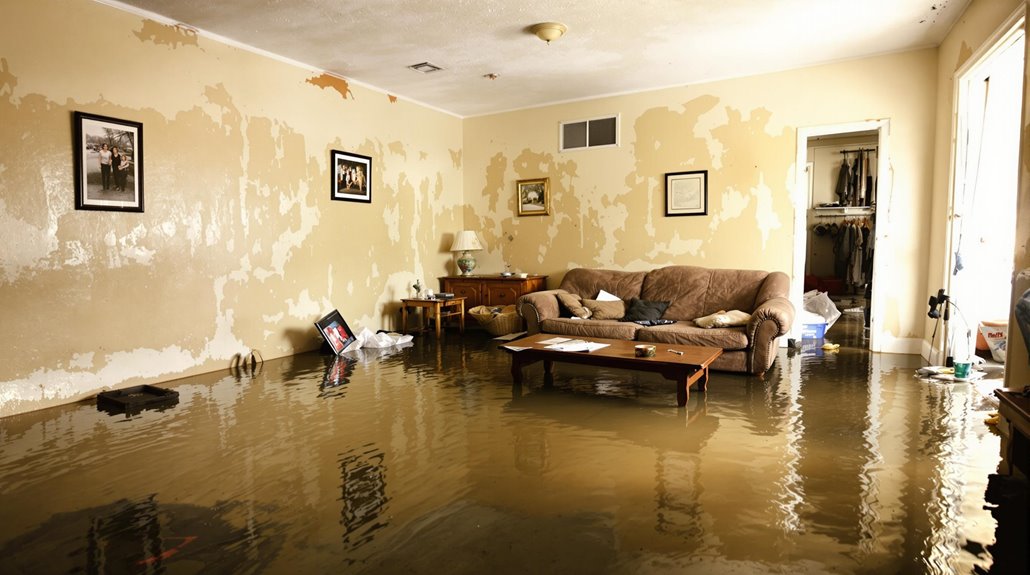
How does one navigate the complexities of purchasing flood insurance policies? Flood insurance is typically not included in standard homeowners insurance policies, making it essential for homeowners in flood-prone areas to obtain separate coverage.
To guarantee adequate financial protection, consider the following:
- Assess flood risk: Determine if your property is located in a designated flood zone or has a history of flooding.
- Review policy limits and exclusions: Understand what damages are covered and what is excluded from your flood insurance policy.
- Consider NFIP policies: The National Flood Insurance Program (NFIP) offers policies that can cover structural damage and personal property in flood-prone areas.
Understanding Flood Insurance Costs And Premiums
Flood insurance costs and premiums can be a complex and nuanced aspect of flood risk management. The average cost of flood insurance policies through the National Flood Insurance Program (NFIP) is approximately $450 annually, with rates varying considerably based on location and property characteristics.
| Flood Insurance Premium Factors | Impact on Premiums |
|---|---|
| High-risk flood zones (SFHAs) | Higher premiums |
| Structural damage and personal property losses | Average claim cost: $39,000 |
| Mitigation measures (elevation, flood vents) | Qualify for discounts under certain programs |
Flood insurance premiums are determined by factors such as flood zone designation, elevation, and coverage selected for both structure and personal property. Homes in high-risk flood zones face higher premiums. Implementing mitigation measures can reduce premiums. Understanding these factors is essential for homeowners to make informed decisions about their flood insurance coverage.
How To File A Claim For Flood Damage
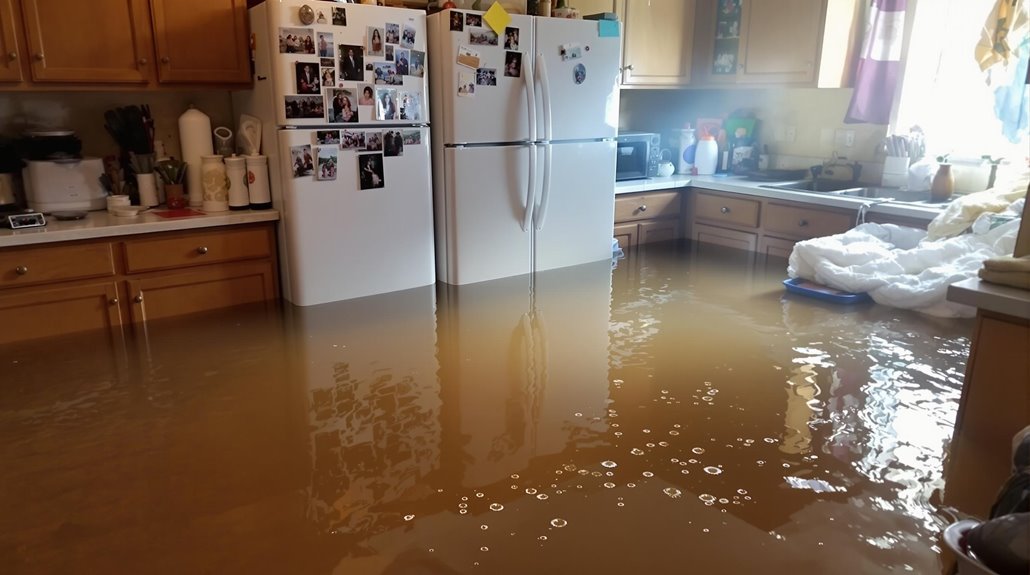
When a flood event occurs, homeowners must act promptly to initiate the claims process by contacting their insurance company to report the damage.
To support their claim, it is essential for homeowners to gather necessary paperwork and thoroughly document the flood damage through photographs, detailed descriptions, and proof of ownership.
Homeowners must also complete a claim form, typically provided by the insurance company, to formally record their losses and initiate the claims assessment process.
Contact Your Insurance Company
In the event of flood damage, promptly contacting the insurance company is essential, as delays in reporting can potentially impact the claim's outcome. Homeowners should contact their insurance company immediately after the incident to initiate the claims process.
The following steps can help facilitate the process:
- Confirm policy coverage: Review the policy to determine if flood insurance is included, as standard homeowners insurance typically does not cover flood damage.
- Document the damage: Take detailed photographs of the affected areas and possessions for evidence when submitting the claim.
- Keep receipts for emergency repairs: Retain records of any temporary repairs made to mitigate further damage, as these can support the claim.
Contact Your Local Flood Damage Public Adjuster
Homeowners who have experienced flood damage and have already contacted their insurance company should consider seeking the expertise of a local flood damage public adjuster to assist with the claims process.
Standard homeowners insurance typically does not provide coverage for flood damage, as this type of loss requires a separate flood insurance policy.
A public adjuster with expertise in flood damage claims can help homeowners navigate the process and guarantee a fair settlement.
By working with a public adjuster, homeowners can receive guidance on what documentation is required to support their claim and guarantee that all necessary paperwork is submitted.
This assistance can be invaluable in securing the compensation due under the flood insurance policy.
Gather Necessary Paperwork & Document Flood Damage
Following a flood incident, gathering all necessary paperwork and thoroughly documenting the damage are critical steps in the claims process.
Homeowners must guarantee they have all required documentation to support their claim, as this will facilitate a smoother and more efficient process.
The following items should be compiled:
- Photographic Evidence: Take clear, detailed photographs of the affected areas, including any damage to walls, floors, and ceilings.
- Receipts and Records: Collect receipts for any temporary repairs made to mitigate further damage, as well as a detailed record of the damage and its cause.
- Policy Documentation: Have a copy of the flood insurance policy on hand to reference coverage limits, exclusions, and procedures for claims.
Complete Claim Form
Initiating the claims process for flood damage requires prompt action and attention to detail. Homeowners must complete a claim form, providing detailed information about the incident, the cause of flooding, and the extent of damages. This form is typically obtained from the flood insurance provider.
| Claim Form Requirements | Description |
|---|---|
| Policy Information | Flood insurance policy number and details |
| Incident Description | Date, time, and cause of flooding |
| Damage Documentation | Photographic evidence and records of affected property |
| Loss Estimation | Estimated cost of damages and repairs |
| Signature | Homeowner's signature verifying the accuracy of the claim |
Accurate completion of the claim form is crucial to facilitate the claims evaluation process. Homeowners should guarantee all required information is provided to avoid delays in processing their claim.
Strategies For Preventing Water Damage At Home
While homeowners insurance can provide financial protection against various types of water damage, proactive measures can be taken to minimize the risk of such damage occurring in the first place.
Preventing water damage at home requires a combination of regular maintenance, inspections, and strategic planning. The following strategies can help mitigate the risk of water damage:
- Regularly inspect and maintain roofing and gutters: Ascertain that gutters and downspouts are clear of debris and functioning properly to prevent clogs and leaks.
- Install sump pumps and water leak detection systems: Automate the removal of excess water and monitor for hidden leaks in plumbing and appliances.
- Implement proper drainage and insulation: Grade the landscape away from the home's foundation and insulate pipes to prevent freezing and bursting.

